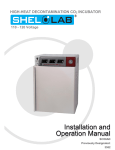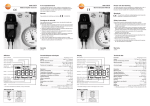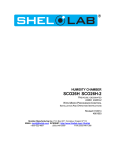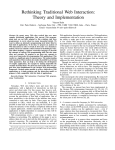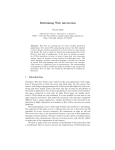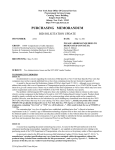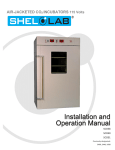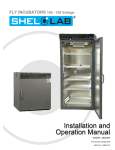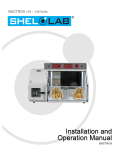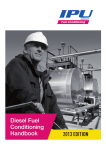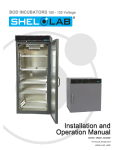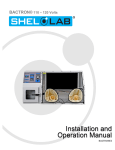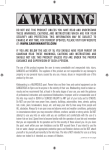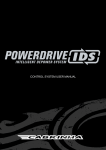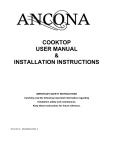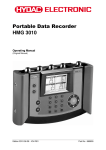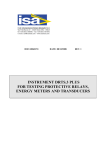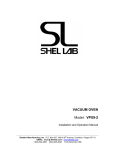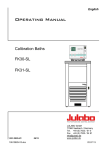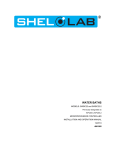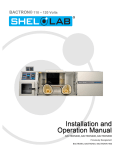Download 4861722 User Manual SCO26H
Transcript
HUMIDFIED CO2 INCUBATOR 115 Voltage Installation and Operation Manual SCO26H Previously Designated: 2428H SCO26H HUMIDIFIED CO2 INCUBATOR Installation and Operation Manual Part Number (Manual): 4861722 Revision: May 15, 2015 These units are compliant with: CAN/CSA C22.2 No. 61010-1:2012 CAN/CSA C22.2 No. 61010-2-010 + R:2009 UL 61010A-2-010:2002 UL 61010-1:2012 EN 61010-1:2010 EN 61010-2-010:2003 2|Page TABLE OF CONTENTS INTRODUCTION........................................................................................................................................... 5 General Safety Considerations ................................................................................................................. 5 Engineering Improvements ....................................................................................................................... 6 Contacting Assistance ............................................................................................................................... 6 RECEIVING YOUR INCUBATOR ................................................................................................................ 7 Inspecting the Shipment ............................................................................................................................ 7 Orientation Photo ...................................................................................................................................... 8 Recording Data Plate Information ............................................................................................................. 9 Reference Sensor Devices ....................................................................................................................... 9 INSTALLATION .......................................................................................................................................... 10 Ambient Conditions ................................................................................................................................. 10 Environmental Factors ............................................................................................................................ 10 Power Source Requirements .................................................................................................................. 10 Water Drain ............................................................................................................................................. 11 Water Quality Requirements ................................................................................................................... 11 Optional: SWPK Water Purification Kit.................................................................................................... 12 Lifting and Handling ................................................................................................................................ 13 Leveling ................................................................................................................................................... 13 Install Incubator in Location .................................................................................................................... 13 Connect to the Water Source .................................................................................................................. 14 Vapor Trap - Drain................................................................................................................................... 14 Initial Cleaning ......................................................................................................................................... 15 Shelving Installation ................................................................................................................................ 15 Connect to the CO2 Supply ..................................................................................................................... 16 Access Port Stopper ............................................................................................................................... 17 GRAPHIC SYMBOLS ................................................................................................................................. 18 CONTROL PANEL OVERVIEW ................................................................................................................. 20 OPERATION ............................................................................................................................................... 22 Theory of Operation ................................................................................................................................ 22 Preparing the Incubator for Use .............................................................................................................. 25 Set the Temperature Set Point ................................................................................................................ 27 Muting the Audible Temperature Alarm .................................................................................................. 28 Automatic Door Cutoff ............................................................................................................................. 28 Set the CO2 Set Point.............................................................................................................................. 29 Muting the Audible CO2 Alarm ................................................................................................................ 30 No Gas Supply Alarm (ngS) .................................................................................................................... 30 Set the Humidity Level ............................................................................................................................ 31 Temperature Accuracy Verification ......................................................................................................... 32 CO2 Accuracy Verification ....................................................................................................................... 34 Set the Over Temperature Limit .............................................................................................................. 36 Load the Chamber................................................................................................................................... 37 Condensate Drainage ............................................................................................................................. 37 Accessory Compatibility .......................................................................................................................... 38 Data Output Capabilities ......................................................................................................................... 38 USER MAINTENANCE ............................................................................................................................... 39 Cleaning and Disinfecting ....................................................................................................................... 39 Minimizing Contamination Exposure ....................................................................................................... 40 HEPA Filter and Gas Lines ..................................................................................................................... 41 3|Page Storage of the SCO26H Incubator .......................................................................................................... 41 Maintaining Atmospheric Integrity ........................................................................................................... 41 Electrical Components ............................................................................................................................ 41 Calibrate the Temperature display .......................................................................................................... 42 Calibrate the CO2 Display ........................................................................................................................ 46 UNIT SPECIFICATIONS............................................................................................................................. 50 Weight ..................................................................................................................................................... 50 Dimensions .............................................................................................................................................. 50 Capacity .................................................................................................................................................. 50 CO2 .......................................................................................................................................................... 51 Temperature ............................................................................................................................................ 51 Power ...................................................................................................................................................... 51 Pressure Conversion Chart ..................................................................................................................... 51 Relative Humidity .................................................................................................................................... 52 PARTS LIST ............................................................................................................................................... 55 Ordering Parts and Consumables ........................................................................................................... 55 4|Page INTRODUCTION Thank you for purchasing a Sheldon Manufacturing, Inc. SCO26H Humidified CO2 Incubator. We know that in today’s competitive marketplace customers have many choices when it comes to constant temperature equipment. We appreciate you choosing ours. Our continued reputation as a leading laboratory product manufacturer rests with you. We stand behind our products and will be here for you if you need us. These incubators are intended for laboratory, industrial, and educational microbiological cultivation applications. These incubators are not intended for use in hazardous or household locations. Before you use the SCO26H read this manual in its entirety to understand how to install, operate, and maintain the incubator in a safe manner. Keep this manual available for use by all operators. Ensure that all operators are given appropriate training before the incubator begins service. GENERAL SAFETY CONSIDERATIONS Note: Failure to follow the guidelines and instructions in this manual may create a protection impairment by disabling or interfering with the unit’s safety features. This can result in injury or death. Your SCO26H and its recommended accessories are designed and tested to meet strict safety requirements. It is designed to connect to a power source using the specific power cord type shipped with the unit. For continued safe operation of your incubator, always follow basic safety precautions including: Always plug the unit power cord into an earth grounded electrical outlet that conforms to national and local electrical codes. If the incubator is not grounded properly, parts such as knobs and controls can conduct electricity and cause serious injury. Avoid damaging the power cord. Do not bend it excessively, step on it, or place heavy objects on it. A damaged cord can be a shock or fire hazard. Never use a power cord if it is damaged. Always position the unit so that end-users can quickly unplug it in the event of an emergency. Do not attempt to move the unit while in operation or before the unit has cooled. Use only approved accessories. Do not modify system components. Any alterations or modifications to your incubator can be dangerous and void your warranty. Follow all local ordinances in your area regarding the use of this incubator. If you have any questions about local requirements, please contact the appropriate agencies. 5|Page INTRODUCTION (CONTINUED) ENGINEERING IMPROVEMENTS Sheldon Manufacturing continually improves all of its products. As a result, engineering changes and improvements are made from time to time. Therefore, some changes, modifications, and improvements may not be covered in this manual. If your unit’s operating characteristics or appearance differs from those described in this manual, please contact your Shel Lab dealer or distributor for assistance. CONTACTING ASSISTANCE If you are unable to resolve a technical issue with the incubator, please contact Sheldon Technical Support. Phone hours for Technical Support are 6am – 4:30pm Pacific Coast Time (west coast of the United States, UTC -8). Please have the following information ready when calling or emailing: the model number and the serial number (see page 9). EMAIL: [email protected] PHONE: 1-800-322-4897 extension 4, or (503) 640-3000 FAX: (503) 640-1366 Sheldon Manufacturing INC. P.O. Box 627 Cornelius, OR 97113 6|Page RECEIVING YOUR INCUBATOR When an incubator leaves the factory, safe delivery becomes the responsibility of the carrier. Damage sustained during transit is not covered by the manufacturing defect warranty. When you receive your SCO26H inspect it for concealed loss or damage to the interior and exterior. If you find damage, follow the carrier’s procedure for claiming damage or loss. INSPECTING THE SHIPMENT Before leaving the factory, SCO26Hs are packaged in high-quality shipping materials to provide protection from transportation-related damage. Carefully inspect the shipping carton for damage. Report any damage to the carrier service that delivered the incubator. If the carton is not damaged, open the carton and remove the contents. Carefully check all packaging before discarding. Save the shipping carton until you are certain that the unit and its accessories function properly. The unit should come with an Installation and Operation Manual and a Certificate of Compliance. Verify that the correct number of accessories are included. Included Accessories 6 Shelves 24 Clips 4 Leveling Feet 1 Power Cord CO2 Tubing Kit A rubber stopper comes installed in the access port on the right side of the incubator. Note: The SCO26H can be connected to a building CO 2 gas system or a supply cylinder (tank). A cylinder regulator is not included with the SCO26H and must be purchased separately. Please see the Accessories section on page 56 if you wish to order one from Shel Lab. Figure 1: Optional CO2 Regulator 7|Page RECEIVING (CONTINUED) ORIENTATION PHOTO Back of Unit Water Inlet Compression Fitting ¼ inch (6.35mm) Back of Unit Pressure Relief Valve Control Panel Power Inlet, Fuse in Inlet Alarm Jacks, Data Plate Back of Unit CO2 In Port Door Gasket Incubation Chamber CO2 Sample Port RS232 Com Port Door Handle View Window Door Latch Access Port Figure 2: SCO26H Sensor Probes: Main Temperature, OTL Temperature, RH% Door Latch Incubation Chamber Door Shelf Standard Mounting Rail Back of Unit Chamber Gasket 8|Page Drain Port ¼ inch (6.35mm) RECEIVING (CONTINUED) RECORDING DATA PLATE INFORMATION Locate the data plate on the back of the unit near the power cord inlet. The data plate contains the incubator model number and serial number. Enter this information below for future reference. Figure 3: Data Plate Date Plate Information Model Number Serial Number REFERENCE SENSOR DEVICES Reference sensor devices or a combined device must be purchased separately for performing display accuracy verifications or calibrations for temperature and CO2 concentration. Reference devices must be accurate to at least 0.1°C and 0.1 % CO2, and should be regularly calibrated, preferably by a third party. For best results, use a digital device with wired-connected temperature sensing probe that can be placed in the incubation chamber through the unit access port. For example: a wire thermocouple probe. A gas analyzer should have sample tubing that can be connected to the incubator external CO2 sample port. Readings that avoid chamber door openings during verification and calibration eliminates subsequent waits for the chamber temperature and gas levels to re-stabilize before proceeding. This also allows temperature and gas verifications or calibrations to be performed simultaneously. Select probes suitable for the application temperature you will be calibrating or verifying the incubator displays at. Alcohol thermometers are insufficient for conducting accurate temperature verifications and calibrations. Do not use a mercury thermometer. Never place a mercury thermometer in the incubation chamber. 9|Page INSTALLATION AMBIENT CONDITIONS The SCO26H is intended for use indoors at room temperatures between 15C and 30C (59F and 86F), at no greater than an ambient 80% Relative Humidity (at 25C / 77F). Allow a minimum of 4 inches (10cm) between the incubator and walls or partitions, and 2 inches (5cm) of clearance above the top of the incubator for unobstructed airflow. Operating the unit outside these conditions may adversely affect its temperature range and stability. For conditions outside of those listed above, please contact your distributor to explore other unit options suited to your laboratory or production environment ENVIRONMENTAL FACTORS When selecting a location to install the incubator, consider all environmental conditions that can affect unit temperature performance. For example: Proximity to ovens, autoclaves, and any device that produces significant radiant heat Heating and cooling ducts, or other sources of fast-moving air currents High-traffic areas Direct sunlight POWER SOURCE REQUIREMENTS When selecting a location for the unit, verify that each of the following requirements are satisfied: The wall power source must match the voltage and ampere requirements listed on the unit data plate. Supplied voltage must not vary more than 10% from the data plate rating. Damage to the unit may result if supplied voltage varies more than 10%. The wall power source must be earth grounded. The unit must be positioned so that all end-users can quickly unplug the power cord in the event of an emergency. The wall power source must conform to all national and local electrical codes. Use a separate circuit to prevent loss of product due to overloading or circuit failure. The unit is provided with a 250V 16amp 5x20mm fuse located in the power cord inlet. These units are intended for 115V 50/60 Hz applications at 12.0 amps. 10 | P a g e INSTALLATION (CONTINUED) WATER DRAIN Condensate is drained out the back of the unit through a copper drain pipe with a 1/4 inch (6.35mm) steel compression fitting. The incubator must be positioned so that the drain empties to either a floor drain or a drain pan that laboratory personnel can regularly empty. Never plug the drain. WATER QUALITY REQUIREMENTS The incubator requires a continual connection to a water source while in operation. Deionized water may not be used in SCO26H! While DI water is useful in variety of laboratory applications, it is an aggressive solvent that attacks most metals and will damage your unit. Use of DI water in the incubator voids the manufacturing defects warranty. Distilled water in the resistance range of 50K Ohm/cm to 1M Ohm/cm, or a conductivity range of 20.0 uS/cm to 1.0 uS/cm is optimum for humidification and cleaning applications. If distilled water is unavailable, potable tap water that meets these standards is acceptable. Filtering is recommended as tap water quality varies greatly by locality, and may create mineral buildups in sensitive components such as, solenoid injection valves and the vapor generator reservoir. These accumulations decrease the efficiency of the humidification system and shorten its lifespan. Additionally, microbiological organisms in tap water may produce organic byproducts that strip protective coatings and accelerate rusting. Water Usage When operating with the humidification control dial set to its mid-point the chamber uses approximately 3 gallons every 24 hours. Usage rates will vary with the incubation chamber temperature, ambient humidity, and the incubator humidification setting. 11 | P a g e INSTALLATION (CONTINUED) Figure 4: Purification Kit OPTIONAL: SWPK WATER PURIFICATION KIT Shel Lab offers an optional kit for purifying potable tap water. The kit is purchased separately from the incubator. Never connect the kit to a deionized water source. The kit will not prevent deionized water from damaging your unit. 18 megohm-cm of resistivity can be achieved with the SWPK. The Adsorber filter removes free chlorine, organics, phosphate complexes, and turbidity. The Universal filter removes ionizable constituents, except free carbon dioxide and silica. The Universal filter reduces the ion concentration level equivalent to a single distillation. Filter Replacement The black Adsorber filter is an active charcoal filter. It typically will last for 6 months to 1 year of use depending on the water quality of your laboratory or workspace tap water source, and the humidity setting of the incubator. The mix-colored Universal filter will gradually turn yellow, starting at the top, and moving to the bottom while in use. The filter’s lifespan is highly dependent on local water quality. It should be replaced when the mixedcolor filter media has turned predominantly yellow around the entire circumference, down to approximately 2.5 inches (6 cm) above where the bottom, white cap meets the body of the cylinder. Figure 5: Purification Kit Plumbing Part Number: SWPK Please see the Ordering Parts and Consumables entry on page 55 for ordering the SWPK. 12 | P a g e INSTALLATION (CONTINUED) LIFTING AND HANDLING The unit should only be lifted by its bottom surfaces using proper heavy lifting machinery such as, a forklift or pallet jack. Handles and knobs are inadequate for lifting or stabilization. The unit should be completely restrained from tipping during lifting. Transporting the unit while lifted is not recommended and may be hazardous. Remove all moving parts, such as shelves and trays, and secure the door in the closed position prior to lifting the unit. Do not attempt to move the unit while in operation or before the unit has cooled. LEVELING The unit must be level and stable for safe operation. Each unit ships with four leveling feet. Insert one leveling foot into each of the four holes in the bottom corners of the unit. Adjust the foot at each corner until the unit stands level and solid without rocking. To raise a foot, turn it in a counterclockwise direction; To lower a foot, turn it in a clockwise direction. Figure 6: Leveling Foot To prevent damage to the feet while in transport turn all feet to the maximum counterclockwise position. INSTALL INCUBATOR IN LOCATION Install the unit in a workspace location that meets the criteria discussed in the previous entries of the Installation section. 13 | P a g e INSTALLATION (CONTINUED) Connection CONNECT TO THE WATER SOURCE Relief Valve Cap (Optional) The incubator water source can be a pressured distilled or potable wall source, or a gravity-fed water reservoir that is regularly refilled. A pressurized source must be regulated to provide between 2 and 4 PSI. 5 PSI is the cracking point of the pressure relief valve. Shipping Cap Follow the steps below to connect the chamber to a water source. Optional: Remove the plastic protective shipping cap from pressure relief value if it will be connected to a drain tube. Water Inlet a. The cap may be left on as a dust guard. Insert tubing from your laboratory water source into the ¼ inch compression inlet on the back of the unit, at the center top. Tighten the compression fitting to a snug fit (wrist strength only). Stabilizing Wrench a. Use of two wrenches is recommended. b. Use one wrench to stabilize the body of the fitting. This protects the fitting and the solenoid it is connected to from potential damage. c. Use the other wrench to tighten the fitting’s compression nut. Tightening Wrench VAPOR TRAP - DRAIN A condensate drain is located on the floor of the test space chamber. The drain has a vapor trap that must be filled prior to putting the unit into operation. Keeping the drain trap full is necessary for the unit to run at is performance specifications. Pour approximately ½ cup (118ml) water into the drain. ½ Cup (118ml) Figure 7: Condensate Drain Vapor Trap 14 | P a g e INSTALLATION (CONTINUED) INITIAL CLEANING The unit was cleaned at the factory, but not sterilized. Additionally, it may have been exposed to contaminants en route during shipping. Cleaning and disinfecting the chamber and shelving prior to placing the unit in operation lowers the chance of microbiological contamination. See the Cleaning and Disinfecting topic in the User Maintenance section (see page 39) for more information on how to clean and disinfect the test space chamber. Remove all wrappings and coverings from shelving prior to cleaning and installation. SHELVING INSTALLATION Perform the following steps to install the unit shelving: Install the shelf clips in the slots located on the shelf standard rails of the chamber interior. a. Squeeze each clip. b. Insert the top tab first. c. Then insert the bottom tab using a rocking motion. Hang the shelves from the clips. Figure 8: Shelving Clip Installed 15 | P a g e INSTALLATION (CONTINUED) CONNECT TO THE CO2 SUPPLY Note: Always use medical grade CO2. Use of non-medical grade CO2 risks introducing contaminants into the chamber, may damage the incubator, and will void the manufacturing defect warranty. Figure 9: CO2 Source Connection The incubator may be connected to either a building CO 2 supply source or a gas supply cylinder (tank). During normal operations the incubator uses only small quantities of CO 2 to maintain the chamber gas concentration. Precise regulation of the gas input flow is vital for the incubator performance. If connecting to a supply cylinder always use a two-stage CO2 pressure regulator. Be aware that some single-stage regulators have 2 gauges. Make certain your regulator is a twostage regulator. Attach the CO2 regulator to a medical grade CO2 cylinder, if using a cylinder supply. Set the cylinder regulator or wall source control to 15 - 20 Pounds per Square Inch (psi). Do not exceed 25 psi. PSI Megapascals Kilopascals Bar 15 - 20 psi 0.103 - 0.137 Mpa 103.42 - 137.89 Kpa 1.03 - 1.378 bar Please see the Pressure Units Conversion table on page 51 in the Unit Specifications section for the formulas for converting psi into other units of pressure measurement. Remove the dust cover from the CO2 in port on the back of the incubator. Connect the gas tubing from to the regulator or wall source to the CO2 In Port on the back of the incubator. a. Connect the black tubing to the regulator or wall source. b. Connect the clear tubing to the CO2 to Chamber port on the back of the incubator. Do not initiate a flow of CO2 to the incubator at this time. End of procedure 16 | P a g e Figure 10: CO2 to Chamber INSTALLATION (CONTINUED) ACCESS PORT STOPPER The SCO26H Incubator is provided with an access port located on the left side of the unit. The incubator is shipped with one (1) rubber access port stopper in the port. The stopper should always be installed in the chamber to obtain the best temperature uniformity and prevent condensation from forming inside the port. A second stopper may be installed on the outside of the unit to prevent dust from building up in the port, but is not required. Figure 11: Port Stopper in Access Port Figure 12: Port Stopper 17 | P a g e GRAPHIC SYMBOLS The incubator is provided with multiple graphic symbols on its exterior and internal surfaces. These symbols identify hazards, and the functions of the adjustable components, as well as important notes in the user manual. Symbol Definition Indicates that you should consult your service manual for further instructions. Indique que l'opérateur doit consulter le manuel d'utilisation pour y trouver les instructions complémentaires. Indicates: Caution hot surface Indique: Avertissement symbole de surface chaude Indicates temperature Repère température Indicates the Over Temperature Limit system Indique le système de dépassement de temperature Indicates AC Power Repère le courant alternatif Indicates I/ON and O/OFF I repère de la position MARCHE de l'interrupteur d'alimentation O repère de la position ARRÊT de l'interrupteur d'alimentation Indicates protective earth ground Repère terre électrique Indicates Up and Down respectively Touches de déplacements respectifs vers le HAUT et le BA 18 | P a g e GRAPHIC SYMBOLS (CONTINUED) Symbol Definition Indicates Potential Shock Hazard Signale danger électrique Indicates the unit should be recycled (Not disposed of in land-fill) Indique l’appareil doit être recyclé (Ne pas jeter dans une décharge) Indicates CO2 gas Indique gaz CO2 Indicates relative humidity (RH) Indique humidité relative (RH) 19 | P a g e CONTROL PANEL OVERVIEW Figure 13: Control Panel Over Temperature Limit Thermostat (OTL) This graduated dial sets the heating cut off point for the OTL temperature limit system. The OTL system prevents unchecked heating of the chamber in the event of a failure of the main digital controller. For more details, please see the Over Temperature Limit System description in the Theory of Operations (page 24). The red Over Temp Activated light illuminates when the Over Temperature Limit system cuts off heating by rerouting power away from the heating elements. Power Switch The power switch controls all power to the incubator and its systems. Power is supplied when the switch is in the ( I ) on position and the Power On light illuminated. Temperature Control and Display Labeled Set Temperature °C, this display shows the current air temperature in the incubation chamber accurate to within 0.1C. The arrow buttons can be used to adjust the temperature set point, or place the display in its temperature calibration mode and then enter a display value correction. Red LED alarm indicators marked High and Low illuminate whenever the temperature deviates by ±1°C or greater from the current set point. The yellow LED marked Mute illuminates whenever an audible deviation alarm is being muted. See the Muting the Audible Temperature Alarm entry on page 28 of the Operations section for more information. The green indicator labeled Heating Activated illuminates whenever the incubator temperature control system is heating the incubation chamber. 20 | P a g e CONTROL PANEL OVERVIEW (CONTINUED) CO2 Display Labeled Set CO2, this display shows the concentration of CO2 in the incubation chamber as a percentage of the chamber atmosphere, with a range of OFF (0%) to 20% and an accuracy of 0.1%. The display shows “LO” until the CO2 sensor registers a concentration in the chamber greater than 0%. This may take several minutes when starting from a 0% concentration. The UP / DOWN arrow pad can be used to adjust the CO2 concentration set point and to mute audible gas deviation alarms. The control can also place the CO 2 display in its calibration mode, and be used to enter a calibration adjustment. Red LED alarm indicators marked High and Low illuminate whenever CO2 deviations of ±1% or greater from the set point take place. The yellow LED marked Mute illuminates whenever an audible deviation alarm is being muted. See the Muting the Audible CO2 Alarm entry on page 30 of the Operations section for more information. Marked CO2 Injecting, this green indicator illuminates when the incubator is injecting CO2 into the incubation chamber. Injections are accompanied by a clicking sound that is the CO2 solenoid opening and closing. Set Relative Humidity This graduated control dial is used to set an approximate level of relative humidity (RH) in the incubation camber to prevent sample dehydration. The green Humidity Injecting light illuminates whenever the humidity vapor generator is injecting water vapor into the chamber airstream. The red Water Low light illuminates when the water level in the vapor generator reservoir is low (below 0.88 liters). While the light is illuminated the vapor generator will remain off in order to prevent overheating. A continuous flow from a water source must be reestablished, which will automatically refill the reservoir, then turn off the light and restart vapor generator operations. 21 | P a g e OPERATION THEORY OF OPERATION The SCO26H is engineered to provide a constant temperature CO2 incubation environment that can be humidified to prevent dehydration of sample media. The unit can obtain a stable, uniform temperature in its chamber, ranging from the room temperature (ambient) +8°C up to 60°C for incubation applications. The CO2 range is a 0 – 20% concentration. The incubator features a heated glass viewing door that allows visual inspection of samples without compromising the chamber CO2 or humidity environment. Heating When powered, the incubator heats to and maintains the incubation chamber air temperature at the currently programed temperature set point. An internal microprocessor stores the temperature set point. The microprocessor board is wired to a solid-state temperature probe located in the chamber airstream on the rear wall. When the processor detects that the chamber temperature has dropped below the temperature set point, it pulses power to a heating element located in a recirculation air duct above the chamber. Once the chamber temperature is stable most heating pulses correct for deviations of less than 0.1°C. The processor employs proportional-integral-derivative analytical feedback-loop functions when measuring and controlling the chamber air temperature. PID-controlled heating pulse intensities and lengths are proportional to the difference between the measured chamber temperature and the current set point. The frequency of pulses are derived from the rate of change in that difference. The integral function slows the rate of pulses when the temperature nears the set point to avoid overshooting. The SCO26H relies on natural heat radiation for cooling. The incubator can achieve a low-end temperature of the ambient room temperature +8°C. The 8 degrees are generated primarily by the operation of the blower fan motor and resulting air compression in the duct spaces. The chamber door is self-heating to bolster the thermal uniformity and stability of the chamber, and to minimize condensation on the glass viewing panel. CO2 Atmosphere The same microprocessor board controls the gas concentration of CO2 in the chamber atmosphere by operating an internal injection solenoid valve connected to the gas input line. The processor monitors CO2 concentration level in the incubator using an infrared sensor in the recirculation duct. The sensor operates on the principle that a specific frequency set of infrared light is absorbed by CO2. The more CO2 present in the air stream from the chamber, the more of that band of infrared is absorbed. The sensor is only sensitive to CO2, so measurement accuracy is consistent, regardless of the presence of other gasses in the incubator. 22 | P a g e OPERATION (CONTINUED) The processor employs proportional-integral-derivative analytic feedback-loop functions when measuring and controlling the CO2 concentration. When the PID are active, injection lengths are proportional to the difference between the measured concentration and the set point. The frequency of injections is derived from the rate of change in the difference. Integrator feedback slows the rate of injection as the concentration approaches the set point, which helps prevent overshoots. When the chamber concentration is stable CO2 injections take place in small bursts to correct for deviations less than 0.1%. The incubator is not provided with a means to actively remove CO2 from the chamber atmosphere. Air Circulation The incubator continually circulates air internally while powered. An air stream of heated, humidified, and CO2-encriched atmosphere is forced through vent holes on back wall of the chamber and blows across the shelf space. It is then pulled upward at the front of the chamber by the action of the blower fan and back into the recirculation duct. The heating element is located in the recirculation duct. Water vapor and CO 2 are injected downstream of the heating element in the duct. A Peltier effect thermoelectric cooler unit provides condensation management with a cold plate in the back wall air duct of the chamber, as well as helping to maintain temperature uniformity in the wall duct and chamber. An automatic cutoff switch located on the door frame disables air circulation and heating, as well as CO2 and water vapor, injections whenever the chamber door is open. Humidity Control The incubator is provided with an internal water vapor generator for humidification of the chamber space. The humidification system is operated by the same microprocessor board that controls the chamber temperature and CO2. The RH microprocessor uses a solid state thin film capacitive humidity sensor located on the chamber rear wall to monitor the relative humidity level of chamber atmosphere. The vapor generator maintains a steady supply of mild-temperature water vapor in a pressurized reservoir. A refill float switch in the reservoir opens the water inlet solenoid on the back of the chamber when it falls below approximately 1 quart (880mm). The generator injects vapor into the recirculation duct stream when the RH% sensor probe indicates the test space humidity has fallen below the user-selected level. Humidification is controlled by PID algorithms similar to those used for controlling temperature and CO2. The lengths of humidity injections are proportional to the difference between the measured chamber RH level and the set level. The frequency of injections are derived from the rate of change in the difference, and slowed by the integral function when the chamber level nears the set level to prevent an overshoot. Note: Steam and heated water vapor. Steam is at or hotter than the local boiling point. Heated water vapor is cooler than the local boiling point. The use of heated water vapor rather than steam for humidification allows a greater range of temperatures in the chamber. It also enables improved temperature stability and uniformity by reducing the temperature difference between newly humidified air and air already in the chamber space. 23 | P a g e OPERATION (CONTINUED) Physical and Data Access An access port on the left side of the unit allows sensors such as, thermocouples and humidity meter solid state probes, to be inserted and left in the chamber without compromising the CO 2 atmosphere. An atmosphere sample port for independently verifying the CO2 concentration in the chamber is provided on the left side of the unit, adjacent to an RS232 data communications port. The com port outputs CO2, humidity, and temperature levels once per minute as a digital log line. Jack ports on the back of the unit provide the same outputs as analog 4 – 20 milliamp signals for use by a building monitoring system. Please see the Data Outputs entry on page 38 for more details. The Over Temperature Limit System (OTL) When set, the OTL system prevents runaway heating in the event of a failure of the temperature microprocessor or its sensor probe by rerouting power away from the heating element whenever the temperature in the incubator chamber exceeds the OTL setting. The OTL is provided with an independent hydrostatic temperature probe on the chamber back wall. The system is set by the end-user at approximately 1°C above the current chamber temperature, typically when operating at the application temperature. Because of its nature as a mechanical cutoff and its lack of PID analytics, the OTL cannot deliver the same degree of temperature stability and measurement precision as the digital display and controls. The OTL System should only be used as a means of heating regulation for the incubation chamber until a failed processor board and its temperature probe can be repaired or replaced. 24 | P a g e OPERATION (CONTINUED) Note: Setting up the incubator for use in a new workspace environment requires an 8-hour period for the unit to come up to and stabilize at temperature, CO2, and, RH levels prior to loading the incubation chamber with samples. During this period the incubator must be powered continually, supplied with water and CO2, and the chamber door closed. Allowing time for stabilization protects samples. It is also necessary for the optional temperature and CO2 display accuracy verification procedures. PREPARING THE INCUBATOR FOR USE Perform the following steps and procedures to prepare the SCO26H for use each time it is installed in a new workspace environment: If you have not done so, clean and disinfect the chamber if required by your laboratory protocol. Please see page 15 in the Installation section. Verify that the side access port stopper is in place on the inside of the unit. a. A clean and disinfected thermocouple probe for performing the optional temperature display accuracy verifications may be inserted through the access port at this time. b. See the optional Temperature Display Accuracy Verification procedure on page 32 for the correct placement of the thermocouple probe. Verify that the workspace power supply and the incubator power requirements listed on the data plate have been matched. a. See the Power Source Requirement entry on page 10. Plug the power cord into the workspace supply outlet. Open the CO2 supply control or gas regulator so it supplies 15 - 20 psi to the incubator. a. It can take up to 20 seconds for CO2 to reach the gas sensor in the SCO26H after the regulator is opened and the incubator is powered up. Place the Power switch in the on ( I ) position. Procedure continued on next page 25 | P a g e OPERATION (CONTINUED) Preparation Procedure Continued Perform the following procedures in the Operation section: a. Set the Temperature Set Point page 27 b. Set the CO2 Set Point page 29 c. Set the Humidity Level page 31 d. Optional: Verify Temperature Display Accuracy page 32 e. Optional: Verify CO2 Display Accuracy page 34 f. Set the Over Temperature Limit page 36 g. Load the Chamber page 37 End of Preparation Procedure 26 | P a g e OPERATION (CONTINUED) SET THE TEMPERATURE SET POINT The unit comes from the factory with a set point of 37°C. Perform the steps below to change the set point to the operational temperature you will be using for your incubation application. Note: The example below assumes adjusting the incubator set point from 35°C to a 37°C application temperature. Set Temperature Set Point Turn the OTL control clockwise to the maximum, if not already set to max. a. This prevents the Safety cutoff system from interfering with this procedure. Press and release either of the temperature arrows to activate the temperature set point adjustment mode. a. The temperature display will briefly flash the letters “SP” to indicate the Set Point is about to be displayed. b. The temperature display will then show the flashing, adjustable temperature set point. Note: The display will automatically exit the adjustment mode after 5 seconds of inactivity, with the last shown set point value saved. Set Point Adjustment Mode Initial Set Point Use the Up or the Down arrow keys to adjust the set point to your application temperature. New Set Point Wait 5 seconds after entering the set point. a. The display will stop flashing, and the set point is now saved in the controller. b. The chamber will now automatically heat or passively cool to match your set point. c. The display will revert to showing the current chamber air temperature. Adjusting to Set Point See the Set the OTL procedure on page 36 for how to set the OTL system once the incubation chamber has stabilized at your application temperature set point, or after you have performed any display verifications or calibrations. End of Procedure 27 | P a g e OPERATION (CONTINUED) MUTING THE AUDIBLE TEMPERATURE ALARM An audible and visual high or low deviation alarm will activate if the incubation chamber temperature deviates by 1°C above or below the temperature set point. The low deviation audible alarm has a delay of fifteen minutes. This prevents the low alarm from sounding whenever the doors are opened, causing a temporary drop in temperature. To mute an active high or low deviation alarm, press and hold either the Up or Down arrow on the Temperature Control panel, until the amber Mute LED illuminates and the audible alarm shuts off. The audible alarm component will remain muted for the duration of the current temperature deviation. The visual alarm indicator will remain illuminated. Any new deviation of ±1°C or greater will reactivate the audible alarm. Figure 14: Low Alarm Muted AUTOMATIC DOOR CUTOFF Whenever the incubation chamber door is opened, the unit stops the flow of CO2 into the chamber, depowers the heater element and water vapor generator, and ceases operation of the internal blower fan. This limits the amount of CO2 and humidity released into the workspace around the incubator. It also prevents the heater from attempting to counteract the continual inflow of cooler air, which would cause a significant heat spike once the door is closed. Normal CO 2 injections, humidification, heating, and fan operation all resume automatically when the door is closed. 28 | P a g e OPERATION (CONTINUED) SET THE CO2 SET POINT The incubator comes from the factory set to Off. Set the CO2 set point to that of your application. The gas supply must deliver 15 - 20 psi to the throughout this procedure. The CO2 display will read “LO” until enough CO2 has built up, sufficient for the sensor to register a concentration greater than 0%. Note: The example below represents adjusting the CO2 set point from 3 to 5%. SET CO2 Press either the Up or Down arrow button on the CO2 panel. a. The display will flash the letters “SP” for set point. b. A flashing, adjustable CO2 set point will appear in the display. Note: The display will automatically exit the adjustment mode after 5 seconds of inactivity, with the last shown set point value saved. Initial Set Point SET CO2 Use the Up or the Down arrow keys to adjust the set point to your application CO2 concentration. New Set Point Wait 5 seconds after entering the set point. SET CO2 a. The display will stop flashing, and the set point is now saved in the controller processor. b. The chamber will now automatically inject CO2 or allow the current level to decay in order to achieve your set point,. c. The display will revert to showing the current chamber concentration. CO2 Injecting to achieve the new set point. Note: The CO2 display and injections can be set to off when in the set point adjustment mode. Hold the down arrow after the blinking set point appears until the display reads “OFF”. The incubator will cease injecting CO2. End of procedure 29 | P a g e OPERATION (CONTINUED) MUTING THE AUDIBLE CO2 ALARM Visual high or low deviation indicator alarms will activate if the incubator CO2 level deviates 1% above or below the CO2 set point. An audible alarm will sound immediately for a high deviation. The low deviation audible alarm will sound after the visual low indicator alarm has been continually illuminated for 15 minutes. This delay prevents the alarm from sounding whenever a door opening creates a short-lived drop in gas concentration. To mute an alarm, press and hold the CO2 Up or the Down arrow button until the amber Mute LED illuminates. The alarm will stay muted for the duration of the current temperature deviation. Another deviation of 1% will reactivate the audible alarm. Figure 15: High Gas Alarm Muted Figure 16: Gas Alarm Timeline NO GAS SUPPLY ALARM (NGS) If the Low Gas deviation indicator is active for longer than 20 minutes, a second alarm will activate. The letters “ngS” will appear in the CO2 display to indicate No Gas Supply. The alarm will remain active even if the incubator is turned off and turned back on. The NGS Alarm will remain on until CO2 is restored to the chamber. It may take several minutes of CO2 inflow to establish a concentration percentage (%) high enough to deactivate the alarm. Figure 17: No Gas Supply 30 | P a g e OPERATION (CONTINUED) SET THE HUMIDITY LEVEL The SCO26H humidification system is intended to provide relative humidity to slow or prevent sample media from drying out in the chamber. From its minimum to maximum setting the Set Humidity Control dial provides roughly 50 – 90% relative humidity in the chamber. The exact RH% is dependent on the chamber air temperature, the ambient humidity of the laboratory space the incubator is located in, and on the volume of sample media in open or “breathable” containers inside the chamber. When carrying out the Preparing the Incubator procedure, set the Set Humidity dial to its midpoint. a. The incubator must operate humidified if you will be performing a temperature display accuracy verification or calibration. Once samples have been loaded, allow the incubator to operate continually for 2 - 3 days. a. Monitor sample media levels. After 2 or 3 days, adjust the Set Humidity control dial. a. Increase the humidity level by turning the dial to the right (clockwise) if samples are drying out too quickly. b. Leave the dial at the midpoint position if sample media is drying at an acceptable rate. c. Decrease the humidity level by turning the dial to the left (counterclockwise) if the sample media is not drying out and condensation in the chamber is excessive. The dial setting will need to be adjusted if there are significant changes in the volume of sample media in the chamber. The humidification system can be set to off by turning the set humidity dial to its lowest setting (counter clockwise). Water Usage When operating with the humidification control dial set to its mid-point the chamber uses approximately 3 gallons every 24 hours. Usage rates will vary by temperature, ambient humidity, and the humidification setting. 31 | P a g e OPERATION (CONTINUED) TEMPERATURE ACCURACY VERIFICATION Note: Performing a temperature accuracy verification requires a temperature reference device. Please see the Reference Sensor Devices entry on page 9 for the device requirements. Optional: The SCO26H was calibrated at the factory at 37ºC. A verification of the display accuracy may be carried out when preparing the incubator for use, if required by your laboratory or production protocol. If an error between the actual and displayed temperatures is discovered, perform a temperature calibration. Please see the Calibrate Temperature Display procedure on page 42 in the User Maintenance section. Humidity Always verify or calibrate for temperature with the chamber humidified. CO2 A CO2 display verification may be performed concurrently with the temperature verification. Probes Reference device sensing probes may be introduced through the access port. Carefully seat the port stopper over any probe wires. Probes may also be introduced through the chamber door space. Use non-stick, non-marking tape to secure the wires and probe heads. The door must close and latch fully. Place the sensor probe of the temperature reference device as close as possible to the geometric center of the incubation chamber. A thermocouple sensor probe sleeve may be taped to the shelving, as long as the exposed copper end is 2 inches (5cm) away from the shelf (see Figure 19). An exposed sensor probe in direct contact with the shelving may experience heat sinking, which can result in an inaccurate temperature reading. Figure 18: Introducing a sensor probe through the access port. Stability Prior to a verification the chamber must operate humidified at its verification temperature set point for at least 1 hour with no fluctuations of ±0.1°C or greater in order to be considered stabilized. Failure to wait for stabilization will result in an inaccurate verification. For best results, allow the unit undisturbed to run for 8 hours (for example, overnight) after introducing and placing the probes, but prior to performing the verifications. Continued on next page 32 | P a g e Figure 19: Probe End 2 inches (5cm) From Shelf Surface OPERATION (CONTINUED) Verifying the Temperature Display Accuracy Once the chamber has stabilized with no fluctuations of 0.1˚C or greater, compare the reference temperature device and chamber temperature display readings. a. If the readings are the same, or the difference between the two (2) falls within the acceptable range of your protocol, the display is accurately showing the chamber air temperature. The Temperature Verification procedure is now complete. Reference Device Set Temperature °C b. See step 2 if a difference falls outside the acceptable range of your protocol. Reference Device If there is a difference between the two readings, and the difference falls outside the acceptable range of your protocol, perform a temperature calibration to match the Set Temperature display to the actual chamber temperature. Set Temperature °C a. Please see page 42 in the User Maintenance section. End of procedure 33 | P a g e OPERATION (CONTINUED) CO2 ACCURACY VERIFICATION Note: Performing a CO2 display accuracy verification requires a gas reference device. Please see the Reference Sensor Devices entry on page 9 for the device requirements. Optional: The SCO26H CO2 display was calibrated at the factory at a 5% concentration. A display accuracy verification may be performed when preparing the incubator for use, if required by your laboratory or production protocol. If an error between the actual and displayed CO2 concentrations is discovered, perform a temperature calibration. Please see the Calibrate CO2 Display procedure on page 46 in the User Maintenance section. Temperature A CO2 display verification may be performed simultaneously with the temperature display verification, as long as the chamber door is not opened during either procedure. The incubation chamber should be heated to and running at your application temperature, as temperature influences gas diffusion in the chamber. Humidity The incubator should be allowed to come up to humidity in the chamber prior to performing a CO2 verification. Relative humidity affects CO2 distribution indirectly through its influence on the chamber atmosphere temperature. Probes Connect a CO2 reference device sample tube to the sample port, located on the left side of the incubator near the top. Stability Prior to a verification, the chamber must operate at its CO2 set point for at least 1 hour with no fluctuations of ±0.1% or greater in order to be considered stabilized. Failure to wait for stabilization will result in an inaccurate verification. Figure 20: CO2 Sample Port For best results, allow the unit undisturbed to run for 8 hours for heat and humidity stability (for example, overnight) after introducing and placing the probes, but prior to performing the verifications. A CO2 flow may be started to the chamber 2 hours prior to the start of the verification. Continued on next page 34 | P a g e OPERATION (CONTINUED) Verifying the CO2 Display Accuracy Once the chamber has stabilized with no fluctuations of 0.1% or greater, compare the gas reference device and chamber CO2 display readings. a. If the readings are the same, or the difference between the two (2) falls within the acceptable range of your protocol, the display is accurately showing the chamber air temperature. The CO2 Verification procedure is now complete. Reference Device Set CO2 b. See step 2 if a difference falls outside the acceptable range of your protocol. Reference Device If a difference falls outside the acceptable range of your protocol, perform a CO2 calibration to match the Set CO2 display to the actual chamber gas concentration. a. Please see page 46 in the User Maintenance section. Set CO2 End of procedure 35 | P a g e OPERATION (CONTINUED) Note: Test the OTL system at least once per year for functionality. SET THE OVER TEMPERATURE LIMIT The incubator must be operating at your incubation application temperature, and must be stable for at least one hour prior to setting the OTL. Perform the following steps to set up the Over Temperature Limit system for use: Example If you have not done so already, turn the Set Over Temperature Limit control dial clockwise to the maximum position. Turn the Over Temperature Limit control dial counterclockwise until the red Over Temp Limit Activated light illuminates. Slowly turn the dial clockwise until the Over Temperature Limit Activated light turns off. Stop turning the control. Leave the OTL dial set slightly above the activation point. The Over Temperature Limit is now set approximately 1˚C above the current chamber air temperature. End of Procedure 36 | P a g e OPERATION (CONTINUED) LOAD THE CHAMBER Sheldon Manufacturing recommends allowing the incubator to operate for at least 8 hours at your application temperature, CO2, and humidity set points after a cold start before introducing samples. This to allow the chamber to achieve the set points and stabilize. Place sample items and any accessories on the shelves inside the chamber as evenly spaced as possible. Good spacing allows maximum air circulation, a higher degree of temperature uniformity, and reduced condensation. CONDENSATE DRAINAGE Some condensate will be present on the incubation chamber walls when the unit is humidified. The amount is dependent on the chamber RH level, the ambient RH, the chamber temperature, and the number of open media containers in the chamber. Condensate appears whenever the chamber relative humidity matches or exceeds the dew point. The dew point is the humidity level at which the air cannot carry additional water vapor. The higher the chamber air temperature, the higher the dew point will be, as warmer air carries more water vapor than cold air. The chamber form factor is designed to channel condensate to a drain set in the chamber floor. The drain exits the back of the unit, and has a water-filled vapor trap (a U-shaped dip) which chamber atmosphere air from leaking. If the incubator has been out of service for a prolonged period of time, refill the vapor trap with a half cup of water (240mm) before returning the unit to use. Excess Condensate If condensation becomes excessive in the incubation chamber the following may help: Make sure items on the shelves are evenly spaced to allow for good airflow. Ensure the chamber door is closing and latching properly. Are frequent or lengthy chamber door openings causing significant temperature disruptions and chilling the chamber surfaces? If so, reduce the number of openings. Is the incubator exposed to an external flow of cold air such as, an air-conditioning vent or a door to a cooler hallway or adjacent room? Block or divert the air, or reposition the unit. Does the ambient humidity in the room exceed the stated operating range of 80% relative environmental humidity? If so, lower the room humidity. Check the door gaskets for damage, wear, or signs of brittleness or dryness. Arrange for replacement of the gaskets if damaged or excessively worn. Periodically wipe down damp chamber surfaces to remove the condensate. Note: Rising or falling air pressure from weather will adjust the dew point up and down in small increments. If the relative humidity in the test space chamber is already near the dew point, barometric fluctuations may push it across the dew point threshold. Note: Thin air at higher altitudes holds less humidity than the denser air found at or near sea level. 37 | P a g e OPERATION (CONTINUED) ACCESSORY COMPATIBILITY Make sure that any accessory equipment used inside the incubation chamber can safely and effectively operate within your selected temperature, RH%, and CO 2 levels. DATA OUTPUT CAPABILITIES The SCO26H incubator generates data outputs once per minute describing CO2 and humidity percentages, as well as the temperature level using a pair of 4 through 20 milliamp bus analog output modules. These outputs can be connected to a building management system (BMS) or other data monitoring and capture system through the use of three jack ports. The ports accept standard audio jacks available from most electronics retailers. These are also known as ¼ inch 2-pole audio connectors or phono jacks. Jacks are not included with incubator. An RS232 serial port also outputs the same data once per minute as a digital logline. Data Monitoring Systems – Max Resistance For building management and other data monitoring or logging systems the maximum resistance of the current loop driven by either output from the 4-20mA module is 250 Ohms. At higher loop resistances the current value will be erroneously low for parameter values near the top of the scale. Jack Outputs: Parameter Parameter Value at 4mA Parameter Value at 20mA Temperature 0°C 70°C CO2 0% CO2 20% CO2 RH% 0% RH 100% RH Figure 21: Data Jack Ports RS232 Output Parameter Output Channel (RS232) Temperature C1 CO2 C3 RH% C4 Example logline for an RS232 output: C1=37.0 C3=5.0 C4=95 38 | P a g e Figure 22: RS232 Com Port USER MAINTENANCE Warning: Prior to any maintenance or cleaning of this unit, disconnect the power cord from the power supply. Avertissement: Avant d'effectuer toute maintenance ou entretien de cet appareil, débrancher le cordon secteur de la source d'alimentation. CLEANING AND DISINFECTING If a hazardous material or substance has spilled in the incubator, immediately initiate your site’s Hazardous Material Spill Containment protocol. Contact your local Site Safety Officer and follow instructions per the site policy and procedures. The incubator chamber should be cleaned and disinfected prior to first use. Periodic cleaning and disinfection are required to prevent microbiological contamination. Do not use spray on cleaners or disinfectants. These can leak through openings and coat electrical components. Do not use cleaners or disinfectants that contain solvents capable of harming paint coatings or stainless steel surfaces. Do not use chlorine-based bleaches or abrasives; these will damage the chamber liner. Warning: Never clean the unit with alcohol or flammable cleaners. Avertissement: Ne jamais nettoyer l'appareil à l'alcool ou avec des nettoyants inflammables. Cleaning Remove all non-attached incubation chamber components and accessories (shelves, racks, and any additional items), if present. Clean the chamber interior with a mild soap and water solution, including all corners. Take special care when cleaning chamber sensor probes located at the rear of the chamber on the back wall. Clean all removable accessories and components. Clean and disinfect any attached sample tubing and replace if discoloring is present. Rinse the chamber surfaces and shelving with distilled water and wipe dry with a soft cloth. Do not use deionized water. 39 | P a g e USER MAINTENANCE (CONTINUED) Disinfecting Disinfect the incubation chamber on a regular basis. For maximum effectiveness disinfection procedures are typically performed after cleaning. Perform the following steps to manually disinfect the incubator: Turn the unit off. Open all doors and carryout your laboratory, clinical, or production space disinfection protocol. Disinfect the incubation chamber using commercially available disinfectants that are noncorrosive, non-abrasive, and suitable for use on stainless steel surfaces. If disinfecting external surfaces use disinfectants that will not damage painted metal or plastic. Contact your local Site Safety Officer for detailed information on the disinfectants compatible with your cultivation or culturing applications. If permitted by your protocol, remove all interior accessories (shelving and other nonattached items) from the chamber when disinfecting. Disinfect all surfaces in the chamber, making sure thoroughly disinfect the corners. Exercise care to avoid damaging the sensor probes. Gas concentrations from evaporating disinfecting agents can inhibit growth or cause metabolic symptoms in microbiological sample populations. Make sure that chlorines, amphyls, quaternary ammonias, or any other overtly volatile disinfecting agents have been rinsed or otherwise removed from the chamber surfaces, prior to placing samples in the chamber. MINIMIZING CONTAMINATION EXPOSURE The following are suggestions for minimizing exposure of the incubator chamber to potential contaminants. Maintain a high air quality in the laboratory workspaces around the incubator. Avoid placing the incubator near sources of air movement such as, doors, air vents, or high traffic routes in the workspace. Minimize the number of times the incubator chamber door is opened during normal operations. 40 | P a g e USER MAINTENANCE (CONTINUED) HEPA FILTER AND GAS LINES “IN” Sheldon Manufacturing recommends replacing in-line gas HEPA filter once per year, or when the filter is noticeably discolored. HEPA filters are directional, and must be installed facing in the correct direction. The word “IN” is stamped on the rim of the filter assembly on the side that faces toward the gas supply. Gas lines should be replaced when cracking, brittleness, permanent kinking, or other signs of damage are present. Please see the Parts List on 55. Figure 23: Optional In-Line Gas Filter STORAGE OF THE SCO26H INCUBATOR Perform the following steps if the incubator will be out of use for more than 24 hours to prevent microbiological contamination such as, fungus or mold. Disinfect the unit before drying if the chamber and shelving have been exposed to pathogenic microorganisms, or if required by your laboratory protocol. Depower the incubator. Use a soft cloth to dry the chamber surfaces. MAINTAINING ATMOSPHERIC INTEGRITY Periodically, inspect the door latch, trim, catch, and gasket for signs of deterioration. Failure to maintain the integrity of the door system shortens the life span of the incubator. Replacement of the chamber and door gaskets are service-level procedures that should be performed by a qualified service technician. ELECTRICAL COMPONENTS Electrical components do not require maintenance. If the incubator fails to operate as specified, please contact your distributor or Sheldon Technical Support for assistance (please see page 6). 41 | P a g e USER MAINTENANCE (CONTINUED) CALIBRATE THE TEMPERATURE DISPLAY Note: Performing a temperature display calibration requires a temperature reference device. Please see the Reference Sensor Devices entry on page 9 for device requirements. Temperature calibrations are performed to match the temperature display to the actual air temperature inside the incubation chamber. The actual air temperature is supplied by a calibrated reference sensor device. Calibrations compensate for drifts in the unit microprocessor controller as well as those caused by the natural material evolution of the sensor probe in the humidified and heated chamber space. Calibrate as often as required by your laboratory or production protocol, or regulatory compliance schedule. Humidity Always calibrate for temperature with the chamber humidified. CO2 A CO2 calibration may be conducted simultaneously with a temperature calibration as long as the chamber door is not opened during either procedure. Probes Reference device sensing probes may be run through the access port. Carefully seat the port stopper over any probe wires. Probes may also be introduced through the chamber door space. Use non-stick, non-marking tape to secure the wires and probe heads. The door must close and latch fully. Place the sensor probe of the temperature reference device inside as close as possible to the geometric center of the chamber. A thermocouple sensor probe sleeve may be taped to the shelving, as long as the exposed copper end is 2 inches (5cm) away from the shelf (see Figure 25). An exposed sensor probe in direct contact with the shelving may experience heat sinking, which can result in an inaccurate temperature reading. Figure 24: Introducing a sensor probe through the access port. Stability Prior to a calibration the chamber should operate undisturbed and humidified at its application temperature set point for 8 hours in order to stabilize. A common practice is to introduce and place the temperature sensor probe in the chamber, allow the unit to operate and stabilize overnight, and then conduct the calibration the next day. Failure to humidify the chamber may result in an inaccurate calibration and display reading. The chamber is considered stabilized when it has operated for 1 hour with no fluctuations ±0.1°C or greater. Failure to wait for stabilization will result in an inaccurate calibration. Continued on next page 42 | P a g e Figure 25: Probe End 2 inches (5cm) From Shelf Surface USER MAINTENANCE (CONTINUED) Temperature Calibration Once the chamber temperature has stabilized, compare the reference device and temperature display readings. a. If the readings are the same, or the difference between the two (2) falls within the acceptable range of your protocol, the display is accurately showing the test space chamber air temperature. The Temperature Calibration procedure is now complete. Reference Device Set Temperature °C b. If a difference fall outside of your protocol range, advance to step 2. Reference Device A display calibration adjustment must be entered to match the display to the reference device. See next step. Set Temperature °C Place the display in its temperature calibration mode. a. Press and hold both the UP and DOWN temperature arrow buttons simultaneously for approximately 5 seconds. Set Temperature °C b. Release the buttons when the temperature display shows the letters “CO”. The display will begin flashing the current temperature display value. Note: If an arrow key is not pressed for five seconds, the display will cease flashing, and store the last displayed value as the new current chamber temperature value. Continued on next page 43 | P a g e USER MAINTENANCE (CONTINUED) Temperature Calibration (Continued) Reference Device Use the Up or Down arrows to adjust the current display temperature value until it matches the reference device temperature reading. Set Temperature °C After correcting for the difference, wait five (5) seconds. Set Temperature °C a. The temperature display will cease flashing and store the corrected chamber display value. b. The incubator will now begin heating or passively cooling in order to reach the set point with the corrected display value. Allow the incubator sit for at last one 1 hour undisturbed to stabilize after it has achieved the corrected temperature set point. Adjusting to Set Point Set Temperature °C a. Failure to wait until the incubation chamber is fully stabilized will result in an inaccurate reading. Reference Device Compare the reference device reading with the chamber temperature display again. a. If the reference device and the chamber temperature display readings are the same or the difference falls within the range of your protocol, the incubator is now calibrated for temperature. b. See the next step if the readings fail to match or fall outside of your protocol range. Continued on next page 44 | P a g e Set Temperature °C USER MAINTENANCE (CONTINUED) Temperature Calibration (Continued) Reference Device If the two readings are not the same, and the difference still falls outside the acceptable range of your protocol, repeat steps 3 – 7 up to two more times. a. Three calibration attempts may be required to successfully calibrate units that are more than ±2°C out of calibration. Set Temperature °C If the temperature readings of the chamber and the reference device still fall outside your protocol after three calibration attempts, contact your distributor or Sheldon Technical Support for assistance. End of procedure 45 | P a g e USER MAINTENANCE (CONTINUED) CALIBRATE THE CO2 DISPLAY Note: Performing a CO2 display calibration requires a gas reference device. Please see the Reference Sensor Devices entry on page 9 for the device requirements. CO2 calibrations are performed to match the incubator CO2 display to the actual gas concentration in the incubation chamber. The actual concentration is supplied by a calibrated reference sensor device. Calibrations compensate for drifts in the unit microprocessor controller, as well as those caused by the natural material evolution of the IR CO2 sensor when continually exposed to a heated and humidified atmosphere with elevated CO2 concentrations. Calibrate as often as required by your laboratory or production protocol, or regulatory compliance schedule. CO2 Supply The incubator must be powered, the CO2 set point set, and the chamber supplied with CO2 for at least two hours prior to the calibration Temperature The chamber temperature impacts the chamber CO2 concentration, due to its influence on gas diffusion. CO2 calibrations must be performed with the chamber fully heated and stable at your operational temperature set point. A CO2 display calibration may be performed during a temperature calibration as long as the chamber door is not opened during either procedure. Humidity Because humidity impacts CO2 concentration through its influence on temperature stability and uniformity, the CO2 display should be calibrated with the chamber humidified. Probes Connect a digital CO2 analyzer sample tube to the sample port, located on the left side of the incubator near the top. Stability Prior to a calibration the chamber must operate at its CO2 set point for at least 1 hour with no fluctuations of ±0.1% or greater in order to be considered stabilized. Failure to wait for stabilization will result in an inaccurate calibration and incubator display reading. Figure 26: CO2 Sample Port For best results, allow the unit to operate undisturbed for 8 hours supplied to achieve temperature and RH stability (for example, overnight). A continual CO2 supply stream may be introduced a minimum of 2 hours, with the incubator otherwise undisturbed, prior to performing the calibration. 46 | P a g e USER MAINTENANCE (CONTINUED) Calibrate the CO2 Display Once the incubation chamber has stabilized with no fluctuations of 0.1% or greater, compare the gas reference device and chamber CO2 display readings. a. If the readings are the same, or the difference between the two (2) falls within the acceptable range of your protocol, the display is accurately showing the chamber CO2 concentration. The CO2 calibration procedure is now complete. Reference Device Set CO2 b. If there is a difference between the two readings that falls outside the acceptable range of your protocol see the next step. Reference Device A display calibration adjustment must be entered to match the incubator CO2 display to the reference device. Set CO2 Place the display in its CO2 calibration mode. a. Press and hold both the UP and DOWN Set CO2 arrow buttons simultaneously for approximately 5 seconds. Set CO2 b. Release the buttons when the display shows the letters “CO”. The display will begin flashing the current CO2 display value. Note: If an arrow key is not pressed for five seconds, the display will cease flashing, and store the last displayed value as the new current chamber CO2 value. Procedure continued on next page 47 | P a g e USER MAINTENANCE (CONTINUED) Calibrate the CO2 Display (Continued) Reference Device Use the Up or Down arrows to adjust the current CO2 display value until it matches the reference device CO2 reading. Set CO2 After matching the display to the reference device, wait 5 seconds. Set CO2 a. The display will cease flashing and store the corrected display value. b. The incubator will begin injecting CO2 or allow the current gas concentration to decay in order to achieve the set point with the corrected display value. Set CO2 Allow the incubator to sit for at last 1 hour undisturbed to stabilize after it has achieved the corrected CO2 set point. a. Failure to wait until the unit is fully stabilized will result in an inaccurate reading and calibration. Reference Device Compare the reference device reading with the incubator CO2 display again. a. If the reference device and the CO2 display readings are the same or the difference now falls within the range of your protocol, the incubator is now calibrated for CO2. b. Or see next step. Procedure continued on next page 48 | P a g e Set CO2 USER MAINTENANCE (CONTINUED) CO2 Calibration (Continued) Reference Device If the two readings are not the same, and the difference falls outside the acceptable range of your protocol, repeat steps 3 – 7 up to two more times. Set CO2 a. Three calibration attempts may be required to successfully calibrate units that are more than ±2% out of calibration. If the CO2 readings of the display and the reference device still fall outside your protocol after three calibration attempts, contact your distributor or Sheldon Technical Support for assistance. b. Three calibration attempts may be required to successfully calibrate units that are more than ±2% out of calibration. End of procedure 49 | P a g e UNIT SPECIFICATIONS The SCO26H Humidified Incubator is a 115 voltage unit. Please refer to the incubator data plate for individual electrical specifications. Technical data specified applies to units with standard equipment at an ambient temperature of 25°C and a voltage fluctuation of ±10%. The temperatures specified are determined in accordance to factory standard following DIN 12880 respecting the recommended wall clearances of 10% of the height, width, and depth of the inner chamber. All indications are average values, typical for units produced in the series. We reserve the right to alter technical specifications at all times. WEIGHT Shipping 620lbs / 282 kg DIMENSIONS By inches Exterior W × D × H Interior W × D × H 39.3 x 37.0 x 78.5 inches 30.7 x 26.0 x 56.5 inches By centimeters Exterior W × D × H Interior W × D × H 99.7 x 94.0 x 199.4 cm 78.1 x 66.0 x 143.5cm Access Port Diameter 1.45 inches (3.68 cm) CAPACITY 50 | P a g e Cubic Feet Cubic Liters 26 740 UNIT SPECIFICATIONS (CONTINUED) CO2 Range Accuracy Recovery Time 0 – 20% ± 0.1% Less than 5 minutes Range Uniformity Stability Ambient +8ºC to 60ºC ± 0.5ºC at 37ºC ± 0.1C @ 37C TEMPERATURE POWER Model AC Voltage Amperage Frequency SCO26H 115 12.0 50/60 Hz PRESSURE CONVERSION CHART 51 | P a g e UNIT SPECIFICATIONS (CONTINUED) RELATIVE HUMIDITY The relative humidity in the incubation chamber is affected by: The chamber air temperature and heat transfers due to condensation. The current ambient relative humidity and ambient air temperature. The setting of the incubator RH control dial. The volume of sample media inside the chamber stored in open or “breathable” containers. The following graphs show the range of achievable incubation chamber RH and temperature levels under varying ambient conditions. Humidity and Temperature Performance @ Ambient Conditions 20°C 50% RH 50 °C Chamber Condensation. 45 °C Normal Temperature and Humidity Operations 42 Chamber Temperature Minor Chamber Temperature Instability °C 37 ± 0.1° Stability 35 50 55 60 65 70 75 80 Chamber RH% 52 | P a g e 85 90 95 UNIT SPECIFICATIONS (CONTINUED) Humidity and Temperature Performance @ Ambient Conditions 25°C 50% RH 50 °C Chamber Condensation 45 °C 42 Chamber Temperature Minor Chamber Temperature Instability Normal Temperature and Humidity Operations °C 37 ± 0.1° Stability Major Chamber Temperature Instability 35 °C 30 50 55 60 65 70 75 80 85 90 95 Chamber RH% 53 | P a g e UNIT SPECIFICATIONS (CONTINUED) Humidity and Temperature Performance @ Ambient Conditions 30°C 50% RH 50 °C Chamber Condensation 45 °C Chamber Temperature Normal Temperature and Humidity Operations 42 Major Chamber Temperature Instability °C 37 35 50 55 60 65 70 75 Chamber RH% 54 | P a g e 80 85 90 95 PARTS LIST Description Parts Number Description Access Port Stopper, Size 7 Power Cord 125 volt 9ft 5 in (2.86m) NEMA 5-15P CO2 Gas Tubing Kit with InLine HEPA Filter Shelf Clips (Requires 4 per Shelf) Fuse 5X20mm T16A 250V Stainless Steel Shelf Parts Number Leveling Feet ORDERING PARTS AND CONSUMABLES If you have the Part Number for an item, you may order it directly from Sheldon Manufacturing by calling 1-800-322-4897 extension 3. If you are not certain that you have the correct Part Number, or if you need that specific item, please contact Sheldon Technical Support for help at 1-800-322-4897 extension 4 or (503) 640-3000. Please have the model number and serial number of the incubator ready, as Tech Support will need this information to match your unit with its correct part. 55 | P a g e ACCESSORIES The following accessories are available for the SCO26H. CO2 Cylinder Regulator, Dual Stage For use with a gas supply cylinder (tank). Part Number 7150509 Gas Line HEPA Filters In-line HEPA filters should be replaced either once per year or when noticeable discoloration is present. The filter is directional, and must be installed facing in the correct direction. The word “IN” is stamped on the rim of the filter assembly on the side that faces toward the gas source. The filter is plumbed between two sections of gas line. Part Number 2800525 Shel Lab Water Purification Kit Removes minerals, ions, and turbidity, from potable water. Please see page 12 in this manual for a complete description of the purification kit. Part Number SWPK 56 | P a g e

























































